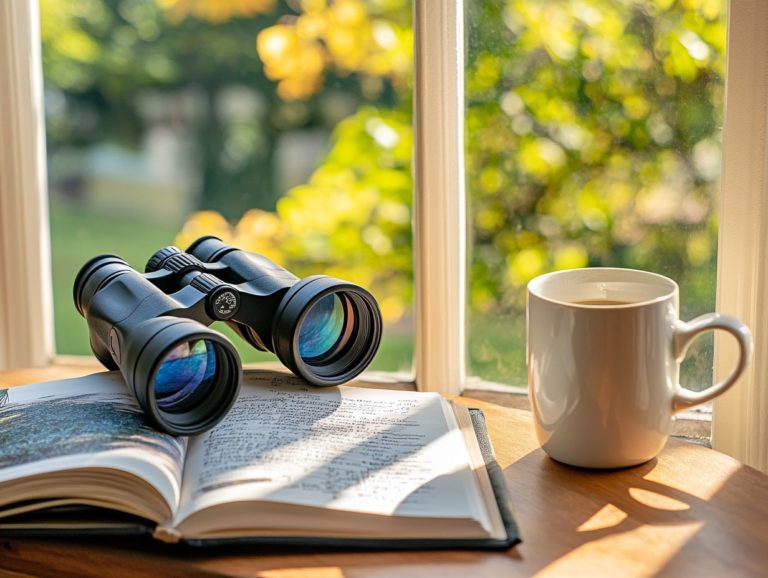How to Maintain Your Bird Watching Equipment?
Bird watching can be an incredibly rewarding hobby, but taking proper care of your equipment is crucial to enhancing your experience.
This article provides essential insights on how to maintain your bird watching gear, covering everything from effective cleaning and storage tips to identifying common issues and extending the lifespan of your binoculars and scopes.
Whether you re contemplating upgrades or simply seeking ways to enhance your current setup, this guide will empower you to ensure that your bird watching adventures are nothing short of exceptional.
Contents
- Key Takeaways:
- Types of Equipment Used
- Proper Maintenance of Bird Watching Equipment
- Common Issues with Bird Watching Equipment
- Extending the Lifespan of Your Equipment
- Replacing and Upgrading Your Equipment
- Frequently Asked Questions
- What are the basic steps for maintaining my bird watching equipment?
- How often should I clean my bird watching equipment?
- What is the best way to clean my binoculars?
- How should I store my bird watching equipment when not in use, including binoculars and a field guide?
- What should I look for when inspecting my birdwatching vest and equipment list?
- Do I need to maintain my bird watching equipment, including my winter gloves and waterproof hiking boots, even if it is not used often?
Key Takeaways:
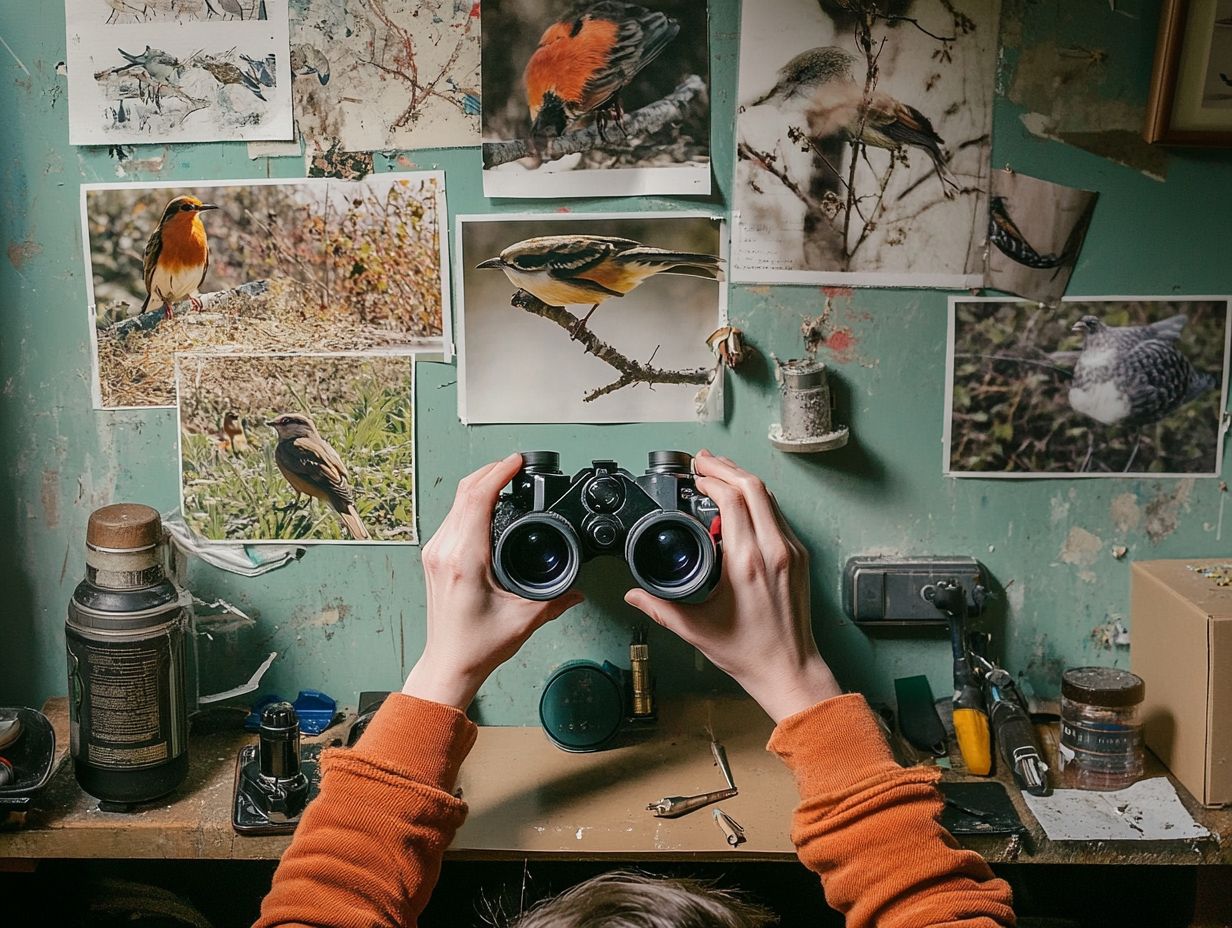
- Clean and store your gear regularly to prevent damage.
- Identify and fix equipment issues early to save money.
- Upgrade your gear when necessary for a better experience.
Types of Equipment Used
As a bird watching enthusiast, you’ll find that a range of specialized equipment is essential to elevate your experience. High-quality binoculars are just the beginning; detailed field guides will become your trusted companions for identifying various species along your journey.
You’ll want to include spotting scopes for those breathtaking distant views. Don t forget a sturdy water bottle to keep you hydrated during those long treks. A camera harness is also invaluable, granting you easy access to capture that perfect moment in nature.
Consider adding hip bags and leg bags to your ensemble; they offer a practical way to carry your essential gear, allowing you to traverse trails comfortably. Each piece of equipment serves a crucial purpose, transforming bird watching into an endeavor that is not only enjoyable but also highly productive.
Proper Maintenance of Bird Watching Equipment
Maintaining your bird watching equipment is essential for ensuring both longevity and optimal performance. To get the most out of your experience, it’s important to know what to look for in bird watching gear, particularly when using tools like binoculars, spotting scopes, and waterproof gear.
Regularly clean your lenses, store your gear in a cool, dry place, and promptly address any signs of wear to significantly extend the life of your equipment.
Check your waterproof gear seasonally to ensure it s ready for any weather conditions you might encounter in the field. Taking care of your equipment is key to enjoying every moment outdoors!
Cleaning and Storage Guidelines
Proper cleaning techniques for your binoculars involve using specialized lens cloths. Your waterproof notebooks and other gear should be cleaned gently with soap and water to avoid any damage.
Maintaining your equipment in peak condition is essential if you re an outdoor enthusiast. Take trail cameras, for instance; they require particular attention. A soft brush works wonders for removing dust and debris, ensuring they function optimally.
After cleaning your tools, store them in a cool, dry place preferably in protective cases to shield them from the elements and prevent long-term wear. Keeping your waterproof notebooks in their designated pouches helps maintain their integrity, ensuring your notes stay intact and legible even in challenging weather conditions.
Regular maintenance makes your gear last longer, ensuring you re ready for every adventure!
Common Issues with Bird Watching Equipment
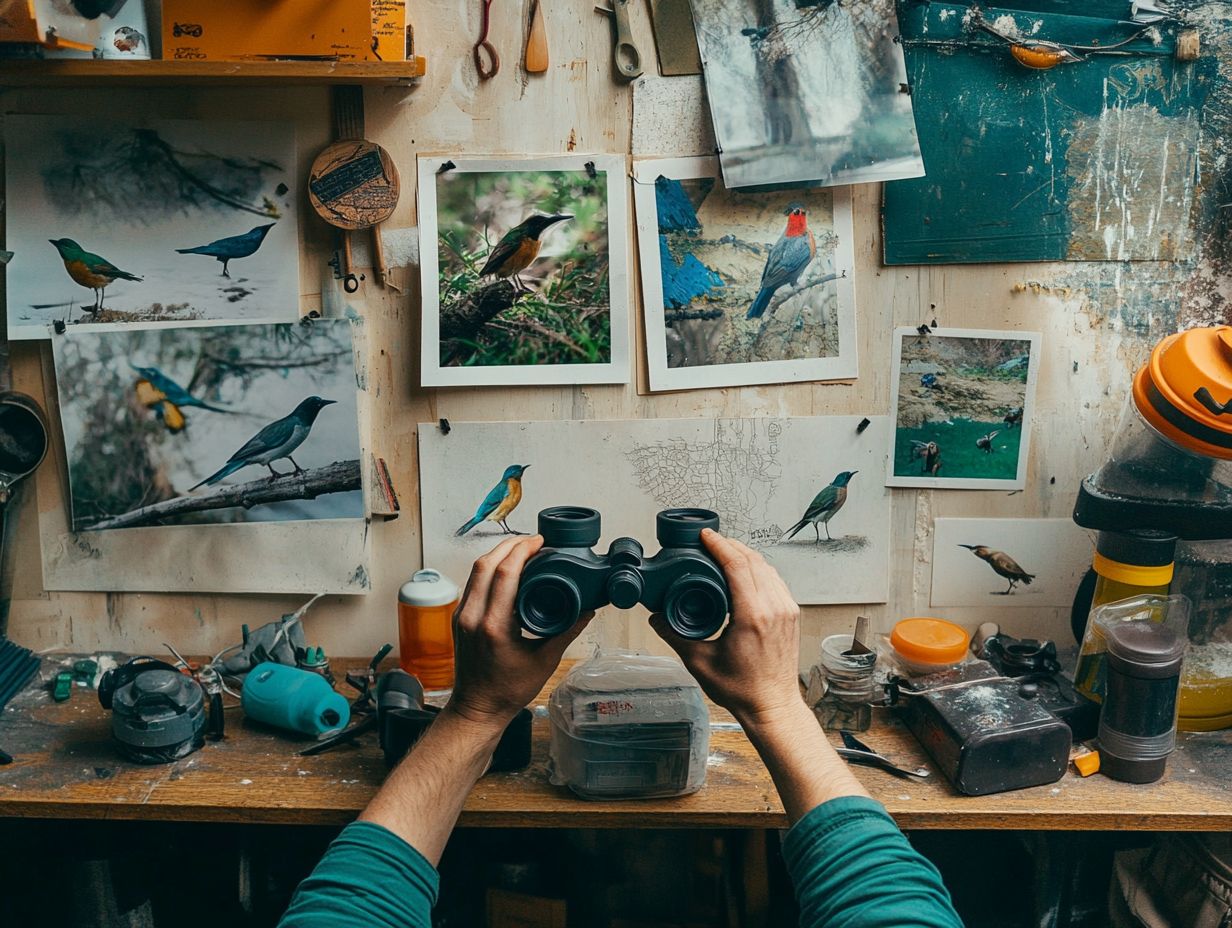
Bird watching equipment can encounter a range of common issues that may disrupt your experience in the field. From lens fogging in binoculars to spotting scopes that don t work well and wear on waterproof gear, these challenges can really put a damper on your adventure.
Identifying these problems early is crucial for effective troubleshooting whether it s tightening a loose camera harness, replacing a faulty personal locator beacon, or ensuring your waterproof hiking boots are in good condition. By being aware of these potential pitfalls, you can fully immerse yourself in the joy of observing wildlife without unnecessary interruptions.
Identifying and Addressing Problems
Identifying common issues in your birdwatching equipment, like blurry images in binoculars or waterproofing failures in hiking gear, enables you to tackle them efficiently and without delay.
Check your lenses for smudges or dirt. Make sure your waterproof gear is sealed properly. Simple solutions, like gently wiping with microfiber cloths or using waterproof sprays, can greatly enhance the functionality of your gear. For more thorough care, refer to spotting scope maintenance tips. Recognizing these issues early not only elevates your birdwatching experience but also extends the lifespan of your equipment.
This proactive mindset highlights the importance of maintenance, allowing you to maximize both pleasure and performance from your investments while protecting against more significant damage in the future.
Extending the Lifespan of Your Equipment
To make your birdwatching gear last longer, you need to take good care of it. Start by routinely inspecting your binoculars and spotting scopes for scratches, and ensure that your waterproof gear remains sealed and in good condition. It’s also helpful to know what equipment is essential for bird watching to ensure you have the right tools for the job.
It s also wise to store your equipment in environments that protect against moisture damage. Use specialized camera backpacks and vests for birdwatching to protect your gear. By incorporating these easy care practices, you ll keep your gear in top shape for years!
Tips for Long-Term Use
Taking care of your birdwatching equipment over time needs a smart plan. To enhance your experience, check out how to use accessories to enhance bird watching. Additionally, consider climate conditions and appropriate storage solutions to safeguard against wear and tear.
To ensure your gear performs at its best, regularly inspect it for any signs of damage, especially in lenses and optics, which are prone to scratches and fogging. After each trip, make it a habit to clean your equipment; a microfiber cloth works wonders for optics, while a gentle brush is perfect for binoculars, helping to maintain their clarity and functionality.
Storing your gear in a temperature-controlled environment is key to thwarting the harmful effects of humidity and extreme temperatures, ultimately prolonging the lifespan of your essential tools. By doing regular check-ups and being careful with your gear, you ll greatly enhance your birdwatching adventures!
Replacing and Upgrading Your Equipment
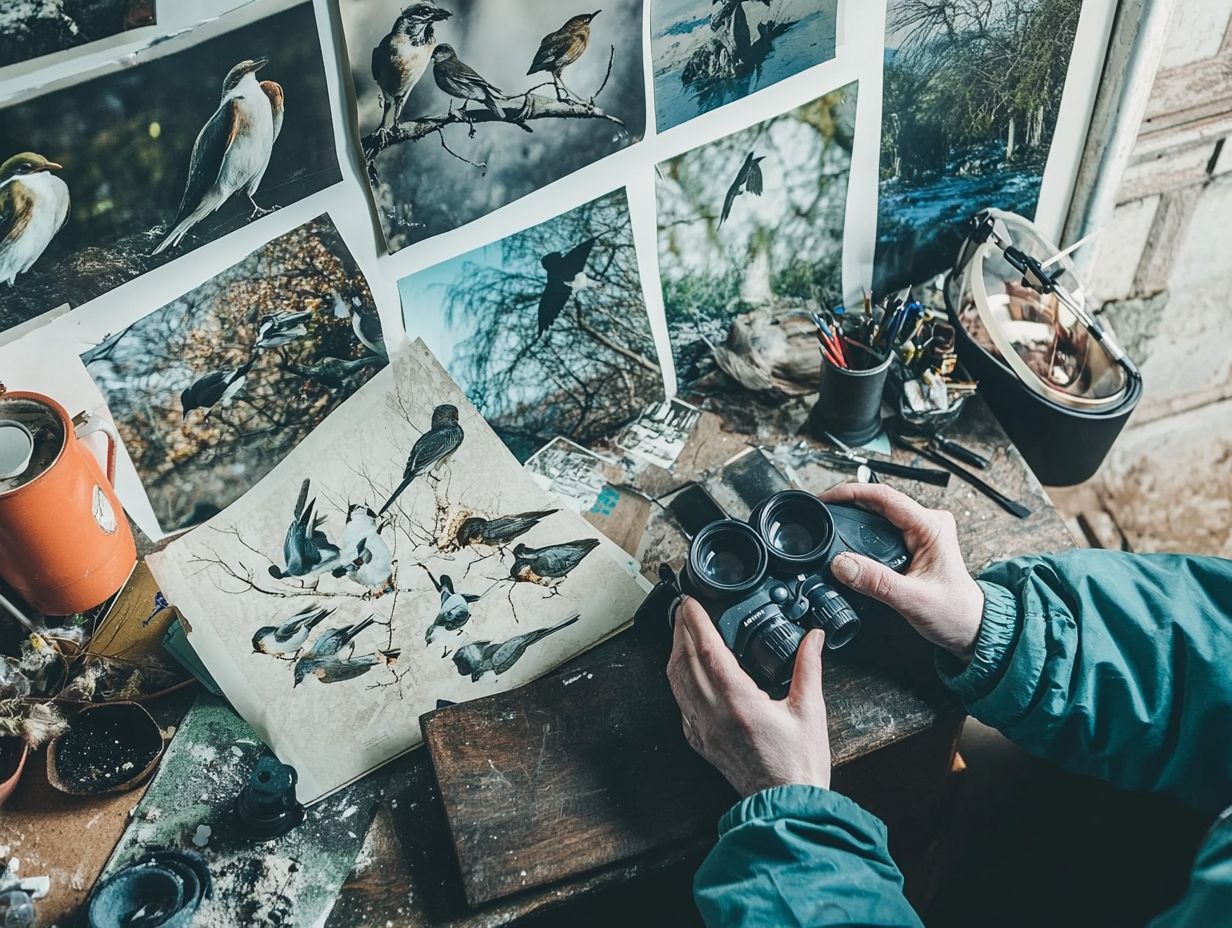
As technology improves, you ll face the exciting choice of when to replace or upgrade your birdwatching gear. With many options in binoculars, spotting scopes, and even trail cameras showcasing enhanced features, staying informed about the latest innovations is essential.
Knowing about the latest gear helps you choose the best options for your needs, whether that means investing in a superior field guide or a more sophisticated smartphone telephoto lens. Recognizing when your current gear falls short of your needs is crucial to ensuring that your birdwatching experience remains enjoyable and fulfilling.
When to Replace and How to Choose Upgrades
When it s time to replace your birdwatching gear, consider performance issues, wear and tear, and compatibility with the latest accessories or technology.
Act quickly! Assess how well your current gear meets your needs before it limits your birdwatching experience. It’s crucial to evaluate any advances in technology that could elevate your birdwatching experience. This might involve exploring recent developments in binoculars or telescopes that offer superior optics or more ergonomic designs.
Diving into user reviews and expert recommendations can provide you with valuable insights into the most reliable brands and models available. Also, balancing your budget with the desire for high-quality options is essential to ensure your chosen equipment meets your personal expectations.
Frequently Asked Questions
What are the basic steps for maintaining my bird watching equipment?
Maintaining your bird watching equipment is crucial. Focus on cleaning, storing, and regularly checking for any damage or wear and tear. For specific guidance, consider these tips for storing your bird watching binoculars.
How often should I clean my bird watching equipment?
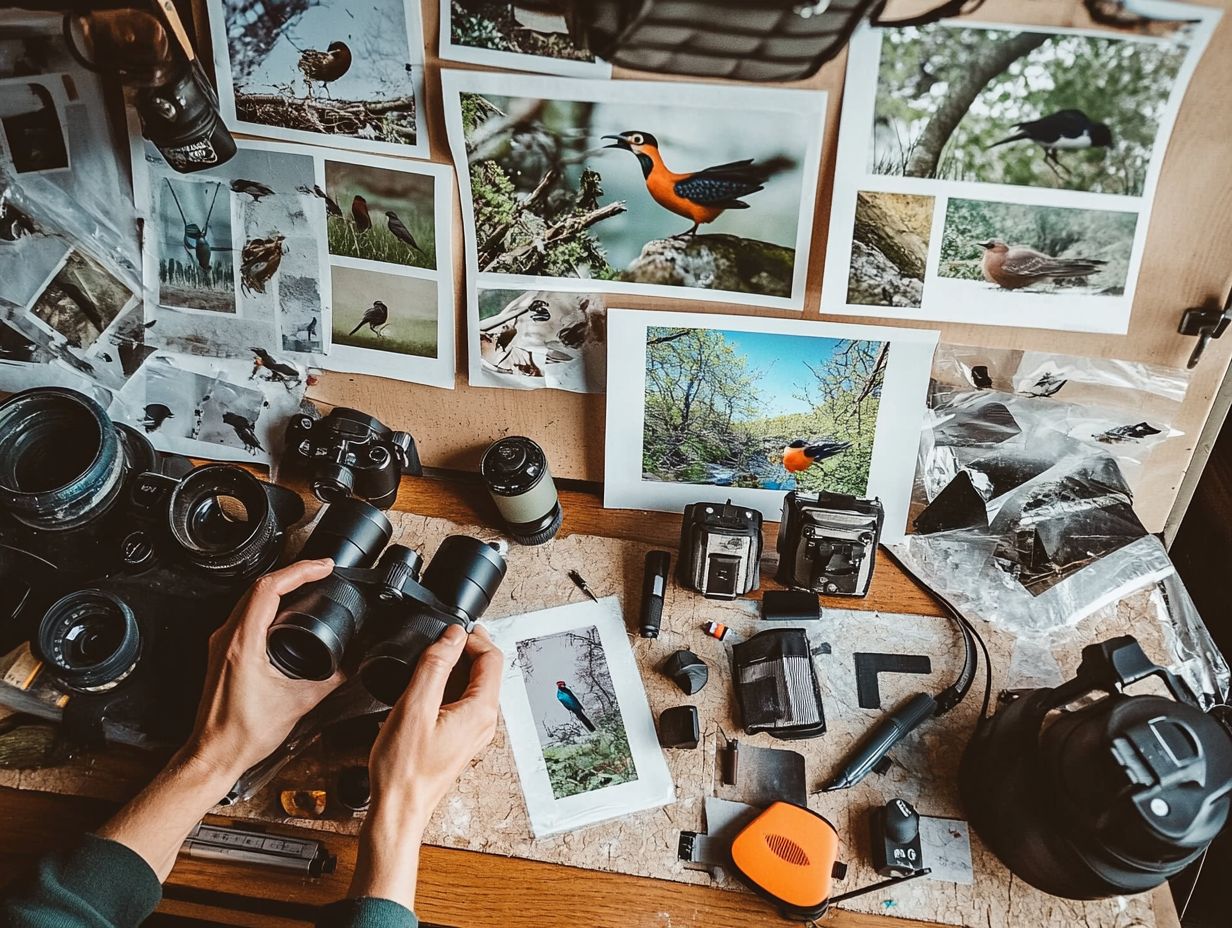
You must clean your bird watching equipment after each use!
Do a more thorough cleaning at least once a month. If you ve been in a dusty or dirty area, clean your equipment right away.
What is the best way to clean my binoculars?
The best way to clean your binoculars is to use a soft, lint-free cloth along with a specialized lens cleaning solution.
Avoid using harsh chemicals or paper products, as they can scratch the lenses.
How should I store my bird watching equipment when not in use, including binoculars and a field guide?
Store your bird watching equipment safely to keep it in tip-top shape! For optimal organization, consider referring to this guide on what to keep in your bird watching backpack. Place items like your camera backpack and waterproof gear in a dry, cool location, away from direct sunlight.
Using a protective case or bag can help prevent any damage.
What should I look for when inspecting my birdwatching vest and equipment list?
When inspecting your equipment, look for any signs of damage, such as cracks or scratches on your spotting scope or smartphone telephoto lenses.
Also, check for any loose or missing parts that may affect how well your gear works.
Do I need to maintain my bird watching equipment, including my winter gloves and waterproof hiking boots, even if it is not used often?
Yes! It is still important to maintain your bird watching equipment, including your insect repellent and personal locator beacon, even if it is not used often.
Dust and moisture can still affect your gear, so clean and store it properly to ensure it s ready for your next adventure.






